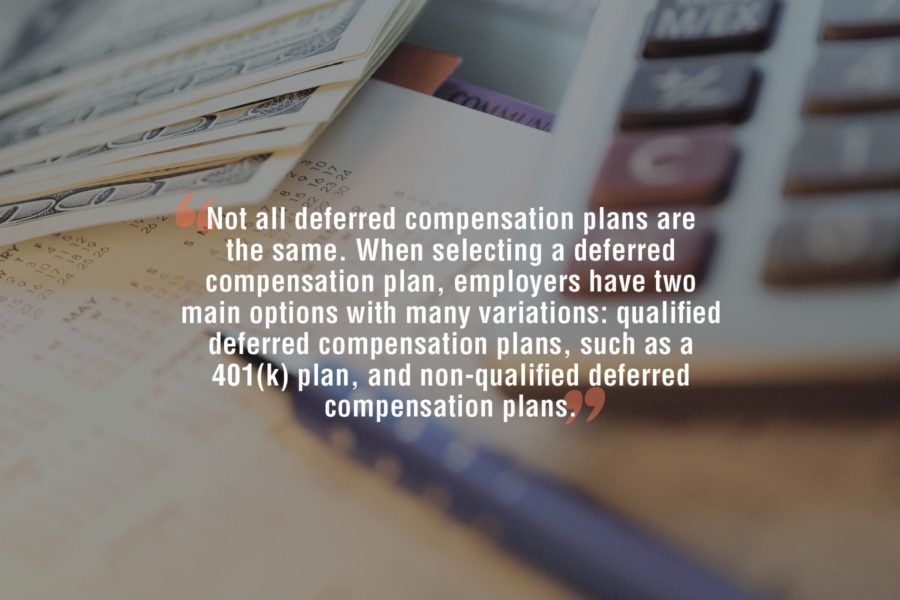In the realm of employee benefits, deferred compensation plans have emerged as a significant asset for high-income earners. By providing a means to defer a portion of the employee’s compensation to a later date, these plans can play a pivotal role in attracting and retaining top talent. Yet, not all deferred compensation plans are created equal, and when deciding between qualified and non-qualified deferred compensation plans, employers must carefully weigh their options.
When selecting a deferred compensation plan, employers have two main options with many variations: qualified deferred compensation plans, such as a 401(k) plan, and non-qualified deferred compensation plans. Here’s a look at how these two options work.
What are deferred compensation plans?
In a deferred compensation plan, a portion of the employee’s compensation is deferred to a later date. This date usually occurs during retirement, although it can come earlier, and multiple payment dates may be selected. This makes deferred compensation plans a popular retirement plan option.
Qualified vs. Non-qualified Deferred Compensation Plans
Although both qualified and non-qualified deferred compensation plans work on the same basic premise of deferring some of the employee’s compensation until a later date, there are key differences.
Qualified plans fall under the governance of the Employee Retirement Income Security Act (ERISA), while non-qualified deferred compensation (NQDC) plans do not. This non-ERISA regulation gives NQDC plans more flexibility and allows employees to defer larger portions of their salary than with ERISA-governed plans. On the flip side, ERISA protections are not extended to these plans. In most cases, non-qualified deferred compensation plans will be used after other retirement options that are governed by ERISA have been maxed out.
It is here, within the framework of qualified plans, that QNECs find their role. Qualified Non-Elective Contributions, also known as QNECs, are employer contributions made on behalf of an employee that are 100% vested when made. They allow employers to help their retirement plans pass non-discrimination tests by allocating contributions to non-highly compensated employees, bolstering the overall appeal of the company’s benefits package.
Section 409A
Non-qualified deferred compensation plans are sometimes called Section 409A plans because they are subject to the rules of Section 409A of the Internal Revenue Code. These rules establish when funds can be disbursed.
Under Section 409A, disbursements are allowed at six different triggering events:
- When the employee separates from the employer.
- When the employee becomes disabled.
- When the employee dies.
- When the company changes ownership or control.
- When there is an unforeseen emergency.
- When a payment is due under the fixed schedule established in the plan documents.
QNECs do not fall under this section as they are immediately vested and aren’t subject to deferred distribution. Instead, they offer immediate value to employees, promoting retention and overall job satisfaction.
Stock Options and 409A
Stocks are a popular investment vehicle, and some companies may want to provide employees with stock options that give them the right to purchase stocks later at a predetermined price.
It is important to note that stock options can be considered a form of non-qualified deferred compensation and may be subject to Section 409A of the Internal Revenue Code.
Why are non-qualified deferred compensation plans attractive?
Non-qualified deferred compensation plans won’t be appealing to all employees. However, these plans make sense for some employees – usually top executives and high-income earners who are interested in the potential tax advantages these plans provide.
With a deferred compensation plan, the employee will not owe income tax until the payment is actually received, which will usually be during retirement. If the employee is in a high tax bracket now and expects to be in a much lower income tax bracket during retirement, the tax savings that result may make the arrangement worthwhile.
In 2021, the tax rate for incomes over $209,425, or $418,850 for joint filers, is 35 percent. In comparison, the tax rate for the lowest bracket is only 10 percent. Executives who can defer current income while in the top bracket to a tax year when they are in the lowest bracket benefit significantly from this arrangement.
While tax advantages are the main draw of deferred compensation arrangements, high-income earners who have maxed out their 401(k) contributions may also be interested in deferred compensation plans as another way to save more for retirement. Employers may also appreciate the option to provide a select group of employees with more generous contributions not subject to the testing and limitations typically associated with a 401(k) or another qualified plan.
Non-qualified Deferred Compensation Drawbacks
As with any savings option, non-qualified deferred compensation plans have disadvantages as well as advantages. It is important to understand the risks before entering into this arrangement.
An important consideration is that these plans are typically maintained for “a select group of management of highly compensated employees.” The ERISA statutes refer to this as a “top hat” group and should generally account for no more than 10-15 percent of all employees.
Another important consideration is benefit security. Non-qualified deferred compensation plan assets remain on the books of the employer, subjecting them to potential business risks from a change in control of the business, a change of heart by the employer, mismanagement or bankruptcy. Without careful planning, these events could result in a loss of the executive’s planned assets.
Another potential drawback is the possibility of a large tax bill when the deferred compensation is finally received. Although the tax rate may be lower at this time, and this is often the goal of this arrangement, this will depend on the actual annual income for the year in question. The rate could be high if the annual earnings place the individual in a high tax bracket, and in that case, a large tax bill could be owed.
A higher income during retirement could also impact other income-based costs, including the Medicare surcharge that applies to Medicare beneficiaries earning more than the standard bracket amount and can result in significantly more expensive Medicare premiums.
QNECs vs. Non-qualified Deferred Compensation Plans
Like non-qualified deferred compensation plans, QNECs within a qualified plan add to the overall attractiveness of an employee’s total compensation package, as they provide immediate, non-deferrable value.
Yet, risks are present. For non-qualified deferred compensation plans, these include the lack of ERISA protections and potential business risks as plan assets remain on the employer’s books. On the QNEC front, while they are fully vested, they count toward an employee’s current taxable income, which may impact high earners’ tax planning strategies.
Should you offer deferred compensation plans to your top executives?
There are different types of deferred compensation plans, and they follow different tax rules and may provide different benefits as well as potential drawbacks.
Non-qualified deferred compensation plans are not appropriate for all employees, and some employees may not be interested. However, for the right employee, this option can be very appealing. Providing the option as part of a benefits package may help your company attract top talent to key executive positions. Therefore, this is an option that deserves serious consideration.
Need guidance?
Our employee benefits department has a team dedicated exclusively to retirement plans. We can help you assess the right approach for your company, find an insurance carrier that’s a cultural and financial fit and help you create streamlined and customized employee benefits offerings and services. Talk to one of our specialists today and discover the Higginbotham difference.


